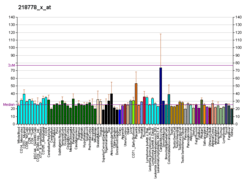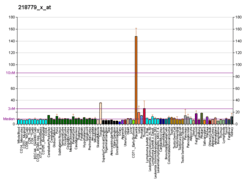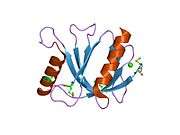EPS8L1
| EPS8L1 | |||||||||||||||
|---|---|---|---|---|---|---|---|---|---|---|---|---|---|---|---|
 | |||||||||||||||
| |||||||||||||||
| Identifiers | |||||||||||||||
| Aliases | EPS8L1, DRC3, EPS8R1, PP10566, EPS8 like 1 | ||||||||||||||
| External IDs | MGI: 1914675 HomoloGene: 15767 GeneCards: EPS8L1 | ||||||||||||||
| RNA expression pattern | |||||||||||||||
   | |||||||||||||||
| More reference expression data | |||||||||||||||
| Orthologs | |||||||||||||||
| Species | Human | Mouse | |||||||||||||
| Entrez | |||||||||||||||
| Ensembl | |||||||||||||||
| UniProt | |||||||||||||||
| RefSeq (mRNA) | |||||||||||||||
| RefSeq (protein) | |||||||||||||||
| Location (UCSC) | Chr 19: 55.07 – 55.09 Mb | Chr 7: 4.46 – 4.48 Mb | |||||||||||||
| PubMed search | [1] | [2] | |||||||||||||
| Wikidata | |||||||||||||||
| |||||||||||||||
Epidermal growth factor receptor kinase substrate 8-like protein 1 is an enzyme that in humans is encoded by the EPS8L1 gene.[3][4]
This gene encodes a protein that is related to epidermal growth factor receptor pathway substrate 8 (EPS8), a substrate for the epidermal growth factor receptor. The function of this protein is unknown. Several alternatively spliced transcript variants encoding different isoforms exist.[4]
References
- ↑ "Human PubMed Reference:".
- ↑ "Mouse PubMed Reference:".
- ↑ Tocchetti A, Confalonieri S, Scita G, Di Fiore PP, Betsholtz C (Mar 2003). "In silico analysis of the EPS8 gene family: genomic organization, expression profile, and protein structure". Genomics. 81 (2): 234–44. PMID 12620401. doi:10.1016/S0888-7543(03)00002-8.
- 1 2 "Entrez Gene: EPS8L1 EPS8-like 1".
Further reading
- Kimura K, Wakamatsu A, Suzuki Y, et al. (2006). "Diversification of transcriptional modulation: Large-scale identification and characterization of putative alternative promoters of human genes". Genome Res. 16 (1): 55–65. PMC 1356129
 . PMID 16344560. doi:10.1101/gr.4039406.
. PMID 16344560. doi:10.1101/gr.4039406. - Wan D, Gong Y, Qin W, et al. (2004). "Large-scale cDNA transfection screening for genes related to cancer development and progression". Proc. Natl. Acad. Sci. U.S.A. 101 (44): 15724–9. PMC 524842
 . PMID 15498874. doi:10.1073/pnas.0404089101.
. PMID 15498874. doi:10.1073/pnas.0404089101. - Gerhard DS, Wagner L, Feingold EA, et al. (2004). "The Status, Quality, and Expansion of the NIH Full-Length cDNA Project: The Mammalian Gene Collection (MGC)". Genome Res. 14 (10B): 2121–7. PMC 528928
 . PMID 15489334. doi:10.1101/gr.2596504.
. PMID 15489334. doi:10.1101/gr.2596504. - Ota T, Suzuki Y, Nishikawa T, et al. (2004). "Complete sequencing and characterization of 21,243 full-length human cDNAs". Nat. Genet. 36 (1): 40–5. PMID 14702039. doi:10.1038/ng1285.
- Offenhäuser N, Borgonovo A, Disanza A, et al. (2004). "The eps8 Family of Proteins Links Growth Factor Stimulation to Actin Reorganization Generating Functional Redundancy in the Ras/Rac Pathway". Mol. Biol. Cell. 15 (1): 91–8. PMC 307530
 . PMID 14565974. doi:10.1091/mbc.E03-06-0427.
. PMID 14565974. doi:10.1091/mbc.E03-06-0427. - Strausberg RL, Feingold EA, Grouse LH, et al. (2003). "Generation and initial analysis of more than 15,000 full-length human and mouse cDNA sequences". Proc. Natl. Acad. Sci. U.S.A. 99 (26): 16899–903. PMC 139241
 . PMID 12477932. doi:10.1073/pnas.242603899.
. PMID 12477932. doi:10.1073/pnas.242603899. - Wu K, Xu Z, Wang M, et al. (1999). "[Cloning and expression analyses of down-regulated cDNA C6-2A in human esophageal cancer]". Zhonghua Yi Xue Yi Chuan Xue Za Zhi. 16 (5): 325–7. PMID 10514543.
This article is issued from
Wikipedia.
The text is licensed under Creative Commons - Attribution - Sharealike.
Additional terms may apply for the media files.

